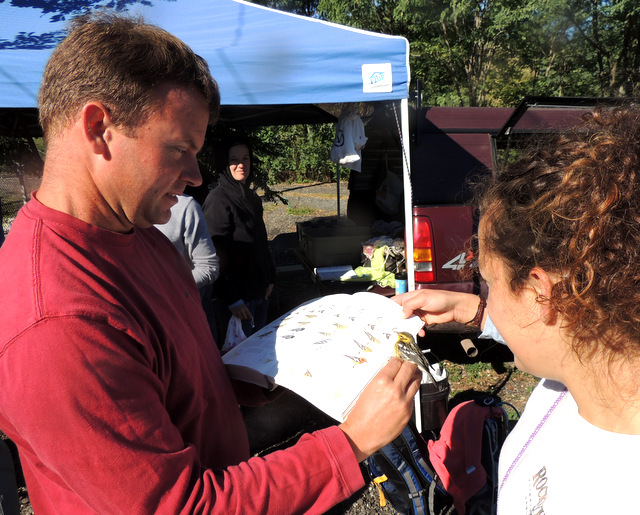
Jim Wright, who keeps this blog for the Meadowlands Commission, also writes a twice-monthly column for the South Bergenite. His latest column is about Mike Newhouse (above) and the Meadowlands Commission’s bird-banding research program:
One of the coolest parts of my job is watching the Meadowlands Commission’s annual fall bird-banding research project.
For the past six autumns, NJMC Naturalist Mike Newhouse and his small group of volunteers have been briefly capturing birds in delicate netting, and then weighing them and determining their age and gender.
The birds are beautiful, even if the setting is old-style Meadowlands — in the parking lot of the closed Erie landfill, next to a PSE&G substation in North Arlington.
Since 2008, Mike and his volunteers have banded more than 22,000 birds in their research on migratory birds and micro-habitats. They place a lightweight aluminum band with a unique nine-digit number on each bird’s right leg before releasing back into the wild. (Don’t worry: The band does not cause discomfort to the birds or affect its ability to fly.)
And since they enter their banding information into a national data base, researchers everywhere can benefit.
In some cases, Mike’s crew may recapture a bird they banded just a few days before. When that happens, they check to see if the bird’s weight has changed. If it has, that means that the landfill is providing a wonderful rest stop for birds as they fly south.
Bird-banding has made Mike realize just how much avian diversity there is on the Meadowlands’ former landfills: “Nobody knows the importance of landfills during bird migration. We’ve captured roughly 80 species on the landfill, which is really amazing. It’s an important habitat.”
Every so often, a bird that Mike banded is recaptured elsewhere, including a common yellowthroat that had bred in Canada and turned up at a banding station in Palm Beach County, Florida.
It is that sort of situation that has caused Mike to appreciate these birds in new ways.
“I think I give them more respect as I see how much they have to go through while migrating,’’ he says. “The dangers they face and the number of miles they fly is amazing. Just think of birds weighing the amount of a quarter flying several thousand miles through weather, predation, and man-made obstacles — buildings, cell phone towers, and wind turbines.”
In addition to banding birds, Meadowlands Commission staffers are also on the lookout for banded and wing-tagged birds from elsewhere. Highlights this summer included three banded first-year peregrines — hatched in Atlantic City, on the Bayonne Bridge and atop a building in Reading, Pa. — and a young great egret from Jamaica Bay in Queens.
This fall, the biggest surprises at Mike’s banding station so far were a so-called common nighthawk (it’s anything but common in the Meadowlands), a black-billed cuckoo, two dickcissels and an abundance of American goldfinches (New Jersey’s state bird).
Since this season’s banding should continue into early November, other treats could be in store.

A NIGHTHAWK?!?!?! Holy mackerel, Mr. Newhouse, that makes the Peregrine I saw chasing down two kestrels two weeks ago seem like a starling. Isn’t getting one of those in a mist net some kind of record?